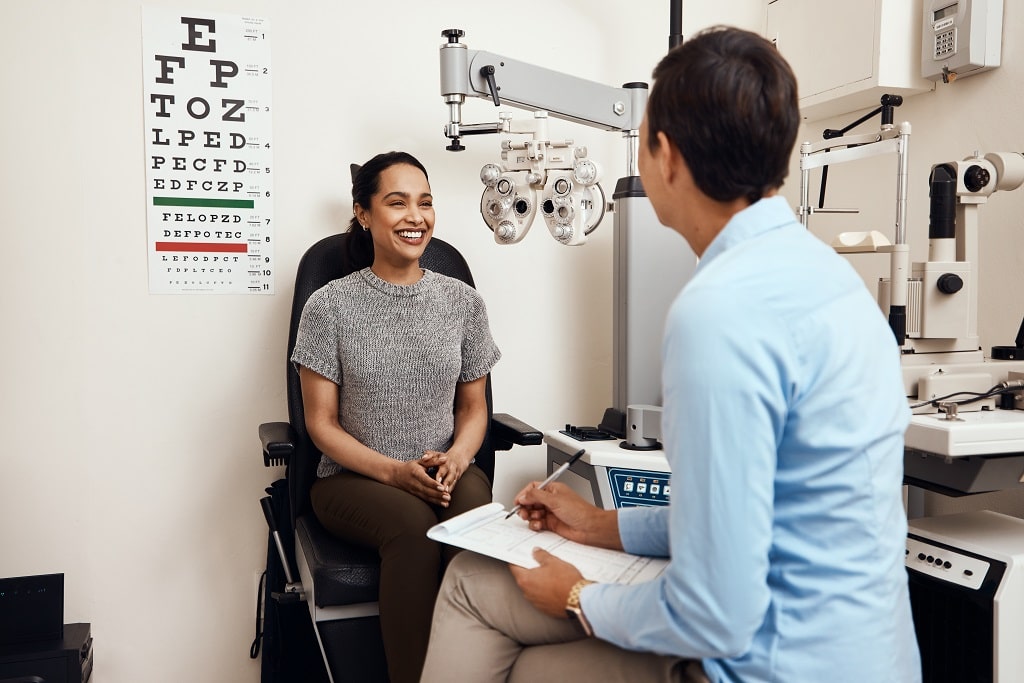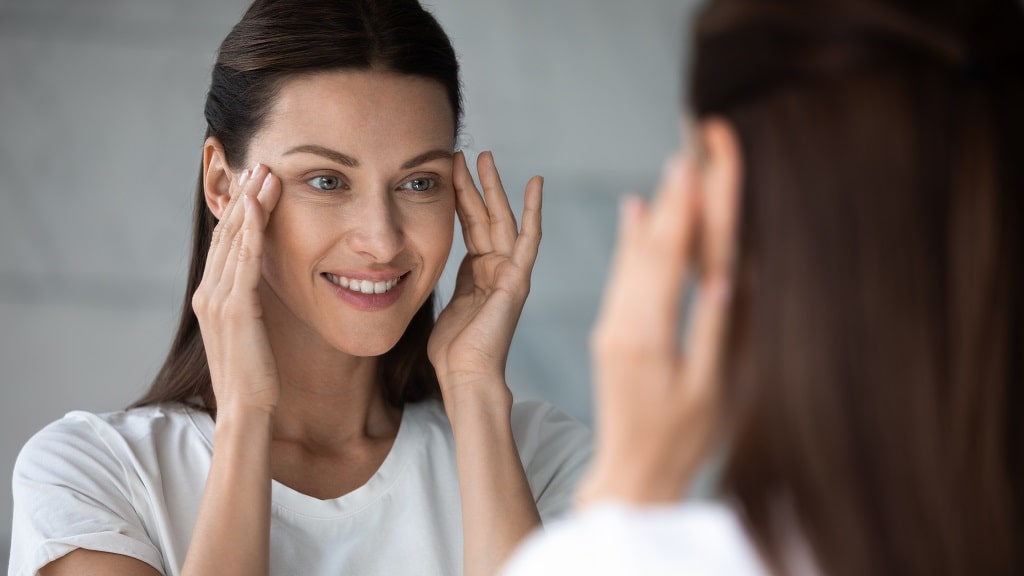
Updated: August 18, 2023

Did you know that over 150 million Americans have poor vision due to a refractive error? These errors make your vision hazy or blurry which can make reading difficult, giving you eye strain and headaches. As a result, this means you’ll need prescription glasses or contact lenses to see clearly.
Small incision lenticule extraction, or SMILE laser eye surgery, is a surgical procedure that helps to reshape your cornea. This allows light to accurately focus on your retina and results in sharper vision. SMILE vision correction in Kansas City is an emerging alternative to LASIK and becoming increasingly popular.
SMILE surgery is used to correct three different types of refractive errors including myopia (nearsightedness), astigmatism (blurred vision at all distances), and presbyopia (an inability to focus your eyes up close).
How well you see depends on how your cornea and lens are able to focus on a clear image of the world before it hits your retina. This bending (refraction) of light rays helps to form a sharp image on your retina. Refraction is performed by the lens and the cornea. Any alterations in the shape of your cornea can result in the image on the retina being unfocused and results in blurry vision.
Opting for the SMILE for astigmatism surgery means that the curvature of your cornea will change. This helps to restore your refraction to normal and gives you sharper vision. It also minimizes the need for new contact lenses or glasses.
Before your SMILE surgery procedure, the ophthalmologist will perform various eye exams to assess your vision and take necessary measurements. These can include the thickness of your cornea, pupil size, and other numbers that are related to the cornea’s surface.
The procedure itself consists of the following steps:
When it comes to SMILE eye surgery recovery time, the process is fast and most people are able to begin working within 24 hours. Within a week, most patients are back to their daily activities.

You’re likely wondering about the safety of SMILE laser eye surgery as this is one of the most important considerations when thinking about the procedure. As the procedure itself is minimally invasive and the procedure has been conducted over 6 million times, you can go into the surgery feeling good about a successful and safe outcome. The success and patient satisfaction rate for this procedure are high and it has been performed in controlled clinical studies since 2007. It has been commercially available since 2011 and has been conducted in over 80 countries throughout the world. Despite all surgical procedures coming with inherent risk, SMILE continues to prove itself as a safe and viable refractive eye surgery for patients.
LASIK surgery and the SMILE procedure come with similarities but there are differences to consider as well. The first major difference between the SMILE procedure vs. LASIK is that SMILE can not correct hyperopia (farsightedness), while LASIK can.
Another difference between SMILE vs. LASIK is that LASIK uses two different lasers to create a precise outcome. A femtosecond laser is first used to form a microscopically thin hinged flap from the epithelial (the outer surface of the cornea). This flap is then folded back to reveal the underlying corneal referred to as stroma. Next, an excimer laser is used to sculpt the stroma using gentle UV rays, allowing the cornea to focus light more precisely. A computer program measures the topography and refractive error in the cornea to guide the laser. With SMILE, only a femtosecond laser is needed.
Of course, there are SMILE eye surgery pros and cons to consider. Research shows that SMILE produces the same visual acuity as LASIK for nearsightedness and astigmatism without the need to create a LASIK-style corneal flap. According to a study of 328 people who had the SMILE procedure, all of them but one person had uncorrected visual acuity (UCVA) of 20/40 or better following surgery and 88% had a UVCA of 20/20 or better.
There is also less risk of dry eye symptoms after SMILE compared with LASIK because SMILE doesn’t need a large corneal flap. This means that fewer corneal nerves are impacted by the procedure, resulting in less of a risk of dry eyes.
The small SMILE incision with the lack of a flap can help the cornea to maintain more strength and resistance to injuries following the procedure. Research suggests that this surgery can help correct high amounts of nearsightedness compared with LASIK without the same level of risk.

Consider the SMILE eye surgery side effects as well. Below, we’ve outlined some of the risks that are commonly associated with the SMILE eye surgery procedure.
Consider the fact that the SMILE procedure involves separating and extracting tissue from the mid-layer of the cornea. A surface corneal abrasion can occur, which can result in additional healing time and symptoms like irritation and inflammation. A bandage contact lens may be recommended to help the abrasion heal.
One of the primary disadvantages of SMILE eye surgery is inflammation. Even though inflammation is a natural result of invasive procedures, more extreme cases of inflammation following the SMILE procedure can result in a prolonged and complicated recovery process. It’s important that SMILE patients are vigilant for vision problems or pain, and if there are any adverse symptoms, they should be communicated early to avoid additional complications.
One of the most common side effects reported by those who undergo laser eye surgery is dry eyes. It is usually temporary. SMILE patients are no exception, but SMILE has been reported to create less post-op dry eye than LASIK. This is likely because the SMILE approach impacts fewer corneal nerves. Six months after both the LASIK and SMILE procedures, there is no difference in dryness.
One may experience starbursts and halos after laser eye surgery. However, these typically subside over time. If they do not, it may be that the power of the eye is not ideal and an enhancement procedure may be recommended.
How much is SMILE eye surgery? While the SMILE surgery cost depends on your location, most places charge anywhere from $2,000-$3,000 per eye. Factors that influence the price include the location of the practice, how much experience the surgeon has, and whether follow-up exams and enhancements are needed.

Not everyone interested in SMILE eye surgery will be a good candidate. It’s important to talk directly with your doctor to determine whether you should move forward with the procedure.
The ideal SMILE eye surgery candidate:
This procedure minimizes the patient’s exposure time while still delivering highly accurate vision correction. SMILE is an appealing option for those with a stabilized prescription, normal cornea measurements, no previous eye surgeries, and overall healthy eyes. Your ophthalmologist will give you a professional recommendation based on the severity of your refractive error in addition to the thickness and curvature of the cornea. As each refractive laser procedure offers strengths, it’s essential that you choose the right one with the help of your doctor.
Even though SMILE surgery offers benefits such as vision correction and eliminating the need for glasses or contacts, the procedure isn’t for everyone. Here are some conditions that could make you unfit for this surgery:
Military deployed in areas with a lot of sun or dry conditions may require more frequent artificial tears and eye protection. As SMILE corrects vision without the flap, it means patients are at less risk of dry eye problems. Similarly, SMILE doesn’t require a significant disruption of the cornea or a lengthy recovery period, making it an ideal option for active duty personnel who are deployed.
The SMILE vision correction procedure is an ideal solution for many patients who are looking to improve their eyesight and reduce their reliance on glasses or contacts. If you’re interested in exploring the SMILE procedure and understanding if you’re a good candidate, our experts at Discover Vision are here to help you! We encourage you to try the most advanced SMILE vision correction self-test to get started. As always, please reach out to us with additional questions or inquiries!